Best support for climbing beans
I’m going to look at the best kind of support for your beans, climbing beans or pole beans. By mid-spring I like to get my bean supports into the ground, so that when those little plants are ready I can get them straight in and I don’t have to make them wait while a frame is constructed for them.
Teepee bean support
One very simple support system is a teepee shape. It could be three canes, four, five or seven, or even more. Be aware that the more canes used, the larger the space it takes up. And it might be worth thinking about how effectively you are using your garden space in that case. Usually one, two or even three beans are planted at the base of each cane.
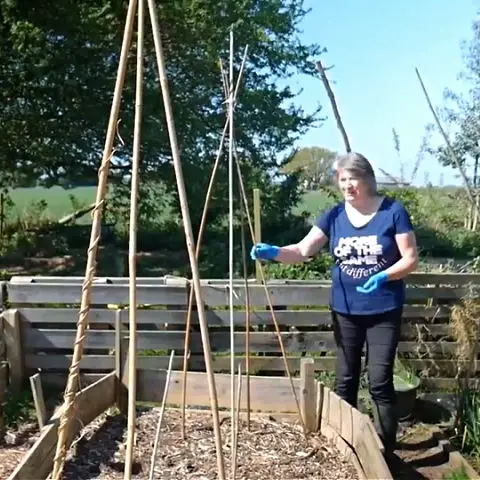
To make a teepee support for climbing beans
- Push the canes into the ground at equal distance apart to create a circle. For three canes this will be a triangle and for four canes a square.
- Gather together near the top. Ensure that the structure does not lean to one side.
- Secure them where the canes cross with some string, baling twine or garden wire.
This is not the strongest of bean support structures, but it is usually sturdy enough. If there is a summer storm with high winds there is a risk of collapse, because the support becomes heavily laden with fully grown plants and beans,
A frame climbing bean support
This is the bean support structure seen in gardens up and down the country. It is simple to create and also an efficient use of space. Usually one or two beans are planted at the base of each cane.

To make an A frame support
- Push canes into the ground at each and tie together to form an inverted V.
- Repeat at the other end of the length you require the support to be.
- Lay a cane horizontally in the V near the top of the cane and secure at each end (if using a row longer than one cane, secure two or more together to create one long cane)

- Push more canes into the ground at intervals of at least 6-8 inches 15-20cms, and attached them to the cross pole using string or baling twine.
- For additional strength, insert bamboo canes at approximately 45 degree angles, facing into the prevailing wind, and tie to the bean support. You can almost weave them to make it quite sturdy.
Alternatively, you can create a basic A frame and use a bean netting over it for the beans to scramble up. For gardeners avoiding the use of plastic in the garden, there are jute string netting options like this one from Gardening Naturally.
Corral support for beans
For a very robust and stable support, this frame is constructed from fencing posts and timber and canes are then secured to the frame.
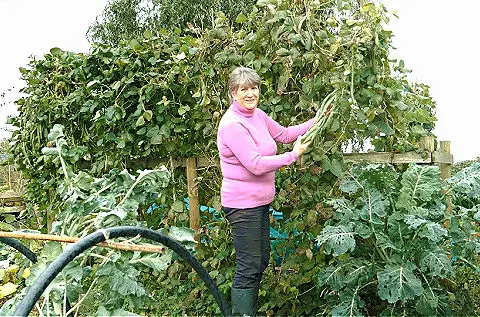
When the plants climb up the canes, the beans are hang down over the path, which offers very easy access to them.
To make the corral support for climbing beans
- Insert fence posts into the ground at approximately 6 feet, 180cms intervals. We use chestnut posts, but square fence posts would work equally well.
- Using screws, attach lengths of wood horizontally at waist to chest height (depending on the height of the fence posts). Use 2 x 4 wood or scrap wood that you available.
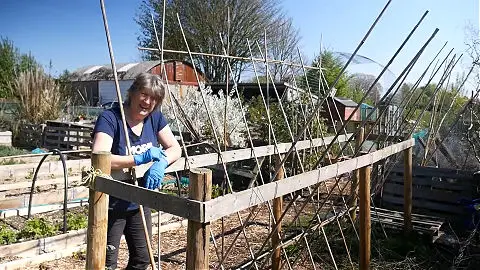
- Push bamboo canes into the ground approximately 6-8 inches, 15-20cms, apart, in a line along the centre of the frame in an X shape. The crossover of the X is near to the ground. This results in the canes sticking out over the top of the frame.
- Secure canes to the horizontal bar using twine, string or cable ties.
- Plant one or two beans per cane.
Harp support for climbing beans
Create your own, or use an existing, pergola to provide the framework for strings for beans to climb. Once the strings are in place it resembles a harp, hence the name. Once again the strings lean outwards a little, providing easy access for harvesting the beans.
To create a harp support
- Build a pergola frame to the length of your desired row. However, it is important to ensure sufficient stability in all directions by adding cross support pieces where necessary.
- Add a base rail really low down and set in slightly towards the centre.
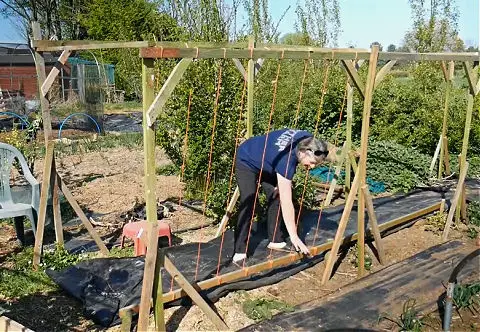
- Use string, twine or baling twine to run from the top rail to the base rail at regular intervals 6-8 inches, 15-20cms apart.
- Plant one bean per string on the outside of the base rail.
Making the best use of your growing space
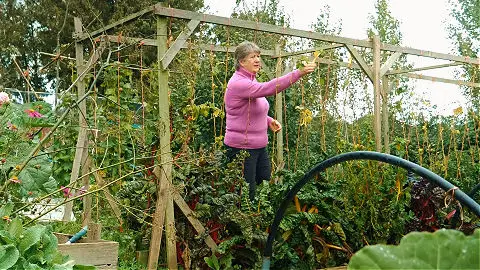
For both the corral and harp designs, you can sow quick-growing crops into the ground in front of the beans. It takes a little while before the beans shade out the light at ground level. You could also consider growing shade loving vegetables below the beans.
Watch Liz Zorab’s videos about how to grow beans on YouTube.
Growing beans without a support system
If you don’t feel you can do something with height, you can grow bush beans or dwarf beans, they won’t get really much taller than your knee. The volume of harvest is not dissimilar, but you do need to bend down to harvest the beans. If bending is a problem for you, climbing beans are a better option.
- Romantic garden ideas in June - June 30, 2024
- Mulching, grow with less effort and less watering - June 26, 2024
- Slug Control – How to get rid of slugs in garden - June 26, 2024
